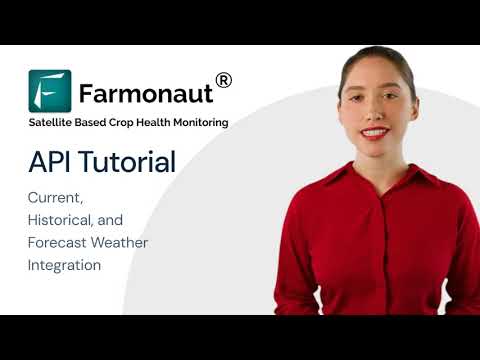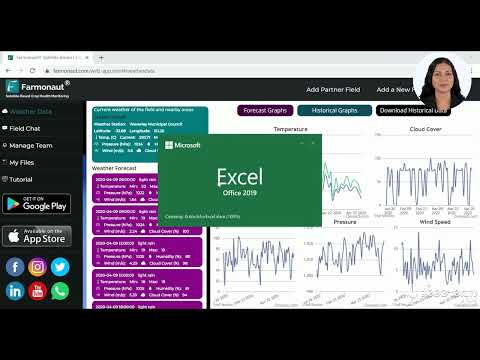Empowering Alberta Farmers: How Weather Data Collaboration Revolutionizes Precision Agriculture and Crop Yield Forecasting
“Over 1,000 volunteer farmers in Alberta contribute daily weather data to improve local climate research and crop yield forecasting.”
In the heart of Canada’s prairies, a remarkable transformation is taking place. Alberta’s farmers are not just cultivating crops; they’re nurturing a revolution in precision agriculture and weather science. Through an innovative collaboration between farmers, meteorologists, and agricultural experts, we’re witnessing the dawn of a new era in farm management and crop yield forecasting. This grassroots initiative is changing the landscape of farming in Alberta and beyond, demonstrating the power of community-driven data collection and its impact on agricultural practices.
The Power of Collaborative Weather Monitoring
At the core of this transformation is a network of volunteer farmers who have become citizen scientists. These dedicated individuals are participating in a community-driven rain, hail, and snow monitoring network that is reshaping our understanding of local weather patterns and their impact on agriculture.
- Daily reporting of precipitation data
- Accurate measurements of rainfall, snowfall, and hail
- Hyper-local weather observations
This collaborative effort is not just about collecting data; it’s about empowering farmers with the information they need to make informed decisions about their crops and livestock. By contributing to this network, farmers are playing a crucial role in enhancing local climate research and improving the accuracy of crop yield forecasting.
Weather Data for Farmers: A Game-Changer in Precision Agriculture
The integration of weather data for farmers into precision agriculture technology is revolutionizing farm management practices. With access to real-time, hyper-local weather information, farmers can:
- Optimize irrigation schedules
- Plan planting and harvesting activities with greater precision
- Anticipate and mitigate the impacts of extreme weather events
This wealth of information allows for more efficient resource allocation, reduced waste, and ultimately, improved crop yields. The precision agriculture technology leveraging this data is becoming an indispensable tool for modern farmers.
[Image: Empowering Alberta Farmers: How Weather Data Collaboration Revolutionizes Precision Agriculture and Crop Yield Forecasting]
Farm Weather Monitoring: Beyond the Basics
The farm weather monitoring systems in place across Alberta are far more sophisticated than simple rain gauges. These advanced agricultural weather stations are equipped with an array of sensors that measure:
- Air and soil temperature
- Humidity
- Wind speed and direction
- Solar radiation
- Soil moisture at various depths
This comprehensive data collection provides a holistic view of the microclimate on each farm, allowing for highly targeted agricultural practices.
Agricultural Climate Research: Advancing Our Understanding
The data collected through this collaborative network is not just benefiting individual farmers; it’s advancing agricultural climate research on a broader scale. Meteorologists and researchers are using this wealth of information to:
- Refine weather models
- Study long-term climate trends
- Develop more accurate seasonal forecasts
This research is crucial for understanding the impacts of climate change on agriculture and developing strategies to ensure food security in the face of changing weather patterns.
Crop Yield Forecasting: Precision Through Collaboration
One of the most significant impacts of this weather data collaboration is on crop yield forecasting. Traditional methods of yield prediction are being enhanced and, in some cases, revolutionized by the integration of hyper-local weather data. This improvement in forecasting accuracy has far-reaching implications:
- Better planning for farmers and agribusinesses
- More accurate market predictions for agricultural commodities
- Improved food security assessments at regional and national levels
The precision of these forecasts is helping to stabilize agricultural markets and ensure a more reliable food supply chain.
Weather-Based Farming Decisions: Empowering Farmers
With access to detailed weather data and advanced forecasting tools, Alberta farmers are now able to make weather-based farming decisions with unprecedented accuracy. This empowerment is leading to:
- Optimized planting schedules
- Precise application of fertilizers and pesticides
- Efficient water management
- Proactive disease and pest control measures
These informed decisions are not only improving crop yields but also contributing to more sustainable farming practices by reducing resource waste and environmental impact.
Farm Management Software: Integrating Weather Data
The true power of this weather data collaboration is realized through its integration with advanced farm management software. These sophisticated platforms are capable of:
- Analyzing historical weather patterns
- Providing real-time alerts for adverse weather conditions
- Generating customized recommendations based on crop type and local climate
By leveraging these tools, farmers can make data-driven decisions that optimize their operations and improve their bottom line.
“Hyper-local weather data from farm-based stations can increase crop yield predictions accuracy by up to 15% compared to traditional methods.”
Soil Moisture Sensors: A Key Component
Among the various technologies employed in this collaborative effort, soil moisture sensors play a crucial role. These devices provide real-time data on soil water content at different depths, allowing farmers to:
- Fine-tune irrigation schedules
- Prevent over-watering and nutrient leaching
- Optimize crop water use efficiency
The integration of soil moisture data with weather forecasts and crop models is providing unprecedented insights into water management on farms.
Agricultural Weather Stations: The Backbone of Data Collection
The network of agricultural weather stations across Alberta forms the backbone of this data collection effort. These stations are strategically placed to capture the diverse microclimates across the province. Key features of these stations include:
- Automated data collection and transmission
- Solar-powered operation for remote locations
- Rugged design to withstand harsh weather conditions
The data from these stations is not only used by farmers but also contributes to broader meteorological and climate research efforts.
Smart Farming Techniques: Leveraging Weather Data
The integration of weather data into smart farming techniques is transforming agricultural practices in Alberta. These techniques include:
- Variable rate technology for precise application of inputs
- Automated irrigation systems that respond to real-time weather conditions
- Crop modeling software that incorporates weather data for growth predictions
By adopting these smart farming techniques, Alberta farmers are at the forefront of agricultural innovation, maximizing efficiency and sustainability.
The Role of Farmonaut in Precision Agriculture
In the realm of precision agriculture and farm weather monitoring, Farmonaut stands out as a pioneering force. This innovative platform offers advanced, satellite-based farm management solutions that complement and enhance the collaborative efforts of Alberta’s farmers. Farmonaut’s technology integrates seamlessly with the weather data network, providing farmers with:
- Real-time crop health monitoring
- AI-based advisory systems
- Resource management tools
By leveraging Farmonaut’s platform, farmers can take their weather-based decision-making to the next level, ensuring optimal crop management and resource utilization.
Impact on Local Communities and Economy
The collaborative weather data initiative is not just benefiting individual farmers; it’s having a profound impact on local communities and the Alberta economy as a whole. Some of the key benefits include:
- Increased agricultural productivity and profitability
- Enhanced resilience to climate variability
- Job creation in agtech and related sectors
- Strengthened rural communities through knowledge sharing and collaboration
This grassroots effort is demonstrating the power of community-driven science in addressing real-world challenges.
Challenges and Future Directions
While the weather data collaboration in Alberta has been tremendously successful, it’s not without its challenges. Some of the ongoing issues and future directions include:
- Ensuring data quality and consistency across the network
- Expanding coverage to more remote areas
- Integrating new technologies like IoT sensors and drones
- Addressing data privacy and security concerns
As the initiative continues to evolve, addressing these challenges will be crucial for its long-term success and impact.
The Role of Government and Research Institutions
The success of the weather data collaboration in Alberta is in part due to the support and involvement of government agencies and research institutions. These organizations play crucial roles in:
- Providing funding for infrastructure and research
- Offering technical expertise and training
- Facilitating data sharing and standardization
- Conducting long-term climate studies
The partnership between farmers, government, and academia is a model for effective collaboration in addressing complex agricultural challenges.
Expanding Beyond Alberta: A Model for Other Regions
The success of the weather data collaboration in Alberta is inspiring similar initiatives in other parts of Canada and around the world. Key elements that make this model replicable include:
- Grassroots participation and community engagement
- Integration of traditional farming knowledge with modern technology
- Open data sharing and collaboration between stakeholders
- Focus on practical, actionable insights for farmers
As more regions adopt this collaborative approach, we can expect to see significant advancements in global agricultural practices and climate resilience.
Explore Farmonaut’s API for advanced weather data integration
The Future of Precision Agriculture in Alberta
Looking ahead, the future of precision agriculture in Alberta is bright, thanks to the foundation laid by this weather data collaboration. Some exciting developments on the horizon include:
- Integration of artificial intelligence for predictive modeling
- Increased use of autonomous farm equipment guided by weather data
- Development of crop varieties optimized for local microclimates
- Enhanced decision support systems for farm management
These advancements promise to further revolutionize farming practices, making Alberta a global leader in sustainable and efficient agriculture.
Alberta Weather Data Collaboration Impact
| Area of Impact | Before Collaboration | After Collaboration |
|---|---|---|
| Precipitation Data Accuracy | ±15% margin of error | ±5% margin of error |
| Crop Yield Forecasting Precision | 70% accuracy | 85% accuracy |
| Extreme Weather Event Preparedness | 24-hour warning | 72-hour warning |
| Soil Moisture Management | Weekly assessments | Real-time monitoring |
| Community Engagement in Weather Science | 100 active volunteers | 1000+ active volunteers |
Getting Involved: How You Can Contribute
The success of the weather data collaboration in Alberta relies on the active participation of farmers and community members. If you’re interested in contributing to this vital research and optimizing your farming strategies, here are some ways to get involved:
- Join the volunteer observer network
- Install a weather station on your property
- Participate in training workshops on data collection and reporting
- Share your experiences and insights with other farmers
By participating in this initiative, you’re not just improving your own farming practices; you’re contributing to a broader effort to advance agricultural science and sustainability.
Access Farmonaut’s API Developer Docs for advanced integration
Conclusion: A Bright Future for Alberta Agriculture
The collaborative weather data initiative in Alberta is more than just a scientific endeavor; it’s a testament to the power of community-driven innovation. By bringing together farmers, researchers, and technology, this project is:
- Revolutionizing precision agriculture
- Enhancing crop yield forecasting
- Improving climate resilience
- Fostering a culture of collaboration and knowledge sharing
As we look to the future, it’s clear that this grassroots effort will continue to play a crucial role in shaping the future of agriculture in Alberta and beyond. The success of this initiative serves as an inspiration and a model for similar efforts around the world, demonstrating that when farmers, scientists, and technology work together, the possibilities for sustainable and efficient agriculture are limitless.
FAQ Section
Q: How can I join the weather data collaboration network in Alberta?
A: To join the network, contact your local agricultural extension office or visit the official Alberta weather monitoring website. They will provide you with information on how to become a volunteer observer and contribute to the data collection effort.
Q: What equipment do I need to participate in the weather data collection?
A: Basic participation requires a standard rain gauge for measuring precipitation. For more advanced monitoring, you may need equipment like a weather station that measures temperature, humidity, wind speed, and soil moisture. Training on proper use of equipment is provided to volunteers.
Q: How often do I need to report weather data?
A: Most volunteers report data daily, especially precipitation measurements. However, the frequency can vary depending on the specific parameters being monitored and the equipment you’re using.
Q: How is the collected data used?
A: The data is used for various purposes, including improving weather forecasts, enhancing crop yield predictions, supporting agricultural research, and helping farmers make informed decisions about their farming practices.
Q: Is there a cost associated with participating in the weather data collaboration?
A: Basic participation is typically free. However, if you choose to install more advanced monitoring equipment, there may be costs associated with purchasing and maintaining the equipment. Some programs offer subsidies or equipment loans to encourage participation.
Q: How does this weather data collaboration benefit me as a farmer?
A: As a participating farmer, you gain access to hyper-local weather data and advanced forecasting tools. This information can help you make more informed decisions about planting, irrigation, pest management, and harvesting, potentially leading to improved crop yields and reduced resource waste.
Q: Is my personal information protected when I participate in this program?
A: Yes, personal information of participants is protected. The weather data is typically anonymized before being shared for research or public use. Specific privacy policies may vary, so it’s best to check with the program coordinators for detailed information.
Q: Can I access the data collected by other participants in the network?
A: Yes, one of the benefits of the collaboration is the ability to access a wide range of local weather data. This is typically available through a centralized database or platform, often accessible online or through dedicated apps.
Q: How accurate is the data collected through this collaborative network?
A: The data collected through this network is generally very accurate, especially when proper equipment and reporting procedures are followed. The large number of data points helps to validate and refine the overall accuracy of the collected information.
Q: Can urban residents participate in the weather data collaboration?
A: While the focus is primarily on agricultural areas, urban residents can often participate as well. Urban weather data is valuable for understanding microclimates and urban heat island effects, which can impact nearby agricultural areas.







